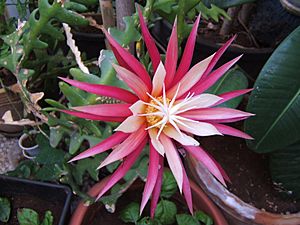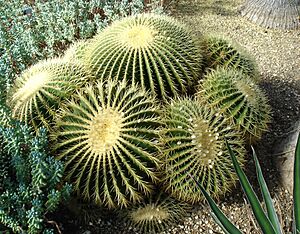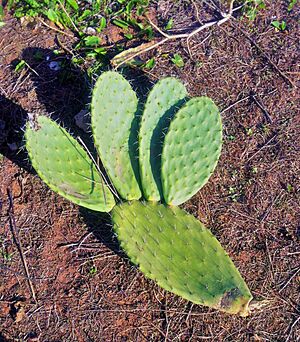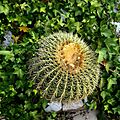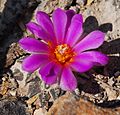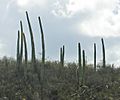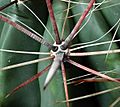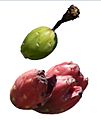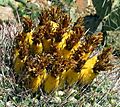Cactus facts for kids
Quick facts for kids CactusTemporal range: 35 mya to present
|
|
|---|---|
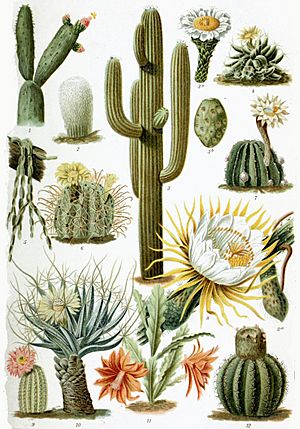 |
|
| Various cacti | |
| Scientific classification |
|
| Kingdom: | Plantae |
| Clade: | Tracheophytes |
| Clade: | Angiosperms |
| Clade: | Eudicots |
| Order: | Caryophyllales |
| Family: | Cactaceae Juss. |
| Subfamilies | |
|
|
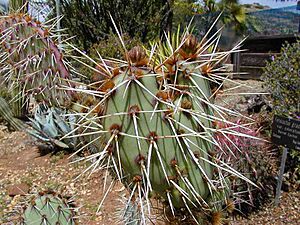
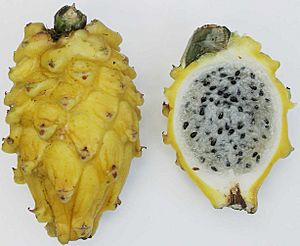
A cactus is a special kind of plant that is super good at living in hot, dry places. Plants that can handle these tough conditions are called xerophytes. Most cacti are also succulents, which means they can store a lot of water inside them.
Cacti belong to a plant family called Cactaceae. There are about 127 different groups (genera) of cacti, with more than 1750 known kinds (species)! Almost all of them come from the Americas, stretching from Patagonia in the south all the way up to parts of western Canada. But one type, Rhipsalis baccifera, also grows in Africa and Sri Lanka.
The word cactus was first used by an ancient Greek thinker named Theophrastus. It comes from the Ancient Greek word kaktos. Theophrastus used it to describe a spiny plant, but we're not sure exactly which one. Today, cacti are an important part of the food chain in dry, hot areas. Many people around the world now grow them in pots or gardens because they are so unique.
Many cacti live in dry places like deserts. Most cacti have sharp thorns (stickers) and thick skin. They come in many different shapes and sizes. Some are short and round, while others are tall and thin. Many cactus flowers are big and beautiful. Some even bloom at night and are pollinated by moths and bats. Some cactus fruits are brightly colored and tasty to eat, and many animals enjoy them too!
Contents
How do Cacti Survive?
An adaptation is something that helps a living thing survive and have more of its own kind. Cacti have many amazing adaptations for living in places that can be dry for a long time. These places can also get a lot of rain sometimes.
Roots for Water
Cacti can have many small, thin roots that stay close to the top of the soil. These roots are great at soaking up water quickly after it rains. The same cactus might also have one long, thick root called a taproot. This taproot grows deep into the soil. It can reach water even when the soil on top is completely dry.
Storing Water and Protection
Cacti store water in their thick stems. These stems are covered with tough skin, which is also covered with a waxy layer. This thick, waxy skin helps slow down how much water the cactus loses. The "leaves" of cacti are actually sharp spines (thorns or stickers). Many animals want the water inside the cactus, but these sharp spines and thick skin keep the cactus safe.
What are Cacti Used For?
Cacti are often grown as houseplants. They are pretty and usually easy to care for. Some cacti are grown in gardens, especially in dry areas. You can even use cacti as a living fence because of their sharp spines! The wood from dead cacti is sometimes used to build houses.
Edible Cacti and Products
People eat the fruit of some cacti, like dragonfruit and prickly pear. There's also a tiny insect called Dactylopius coccus that lives on Opuntia cacti. This insect makes a red dye called cochineal. It feeds on the cactus sap and produces a special acid to protect itself from other insects. This acid is then used to make the red dye.
Cacti Through History
The ancient Aztecs in North America thought cacti were very important. You can find cacti in many of their sculptures and drawings. The national coat of arms of Mexico even shows an eagle, a snake, and a cactus!
Cacti in Europe and Australia
Christopher Columbus brought the first cactus to Europe. Soon, scientists and gardeners became very interested in these unique plants.
The Prickly pear cactus was brought to Australia in the 1800s. People used it as a natural fence and for the cochineal dye industry. But the cactus spread too much and became a problem! Luckily, a small larva from a South American moth helped control it.
Protecting Cacti
Since the early 1900s, interest in cacti has grown a lot. Every year, scientists discover new kinds of cacti. But this has also caused a problem: many cacti have been dug up from the wild. This has made some types of cacti endangered, meaning they are at risk of disappearing forever.
Cactus Stems: No Leaves?
A cactus doesn't have regular leaves because it lives in dry places. Leaves usually lose a lot of water through a process called transpiration. So, by not having leaves, the cactus saves water. The green parts of the cactus are actually its stems. Since they are green, they do the photosynthesis for the cactus, which is how the plant makes its food. These stems also grow prickly needles to protect the cactus from animals that might want to eat it.
Types of Cacti
The cactus family has more than 100 different groups, called genera. Here are a few examples:
Websites
Images for kids
-
Ferocactus species, a cactoid, in its native Arizona habitat
-
Stem of Mammillaria longimamma, showing tubercles
-
Rhodocactus grandifolius is weakly succulent, possesses leaves, and is thought similar to the ancestor of all cacti.
-
Opuntia ficus-indica in Behbahan, Iran
-
Flower of Schlumbergera cut in half, showing typical adaptations to bird pollination
-
Flowers of saguaro showing flattish white flowers adapted for bat pollination
-
Fruit of Schlumbergera cut in half; the length is 1.0~1.5 cm.
-
Peeled fruits of the Indian fig cactus of different varieties on sale in Mexico
-
Lophophora williamsii in the wild
-
Stone carving from Chavín de Huantar, dated to circa 1000 BC, showing a figure carrying what is thought to be the San Pedro cactus
-
Cacti and other succulents growing in the Huntington Desert Garden
-
Cacti at the Mission San Juan Capistrano in California
-
A planted cactus in Gibraltar. The hot and relatively dry climate of the territory allows cacti to thrive.
-
Ariocarpus kotschoubeyanus, an endangered species protected under Appendix I of CITES
-
Cultivated Notocactus warasii at the San Diego County Fair, California
-
Cacti in a greenhouse in Darjeeling, India
-
Tall treelike habit (Pachycereus pringlei)
-
Shorter clustered columnar habit (Ferocactus pilosus)
-
Solitary globular habit (Ferocactus echidne)
-
Unusual flattened spines of Sclerocactus papyracanthus
-
Glochids of Opuntia microdasys
-
Gathering saguaro fruit in 1907
-
Dragon fruit for sale in Taiwan
-
Fruit prepared from Stenocereus queretaroensis
-
Salad including sliced nopales (opuntia pads)
See also
 In Spanish: Cactáceas para niños
In Spanish: Cactáceas para niños


